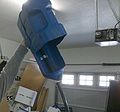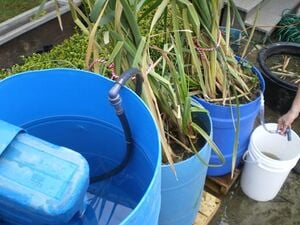

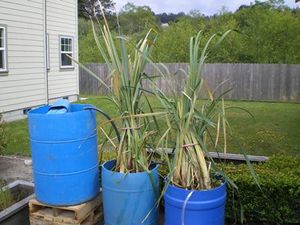

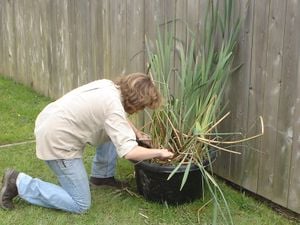
How can an individual, especially in an urban setting, reclaim their water? Grey water filtration has become increasingly popular here in the US as part of the movement towards sustainability. Grey water can be remediated through mechanical, biological, and chemical processes. Our project will focus on using reclaimed materials to construct a system that filters grey water through the use of biological and mechanical filtration processes. For this project our team will be developing a small system for a rooftop application in Brooklyn, NY.
As water use rises its is increasingly important to use the water to it's full extent and explore ways to remediate and reclaim water that has become contaminated. It is our team's belief that we can develop a small system that will provide people with water to grow plants or even tree saplings that can be used in restoration projects. Furthermore, we expect our project to promote sustainable practices, localization of economies and awareness about water reclamation. Our project team will be working with Mary Mattingly, an accomplished NY artist, who has a vision of creating more sustainable habitats for humans in urban areas through the utilization of rooftop space. We will also be advised by Andrew Carter of Carter Environmental and Lonny Grafman of Appropedia.org throughout the design process.
Criteria[edit | edit source]
| Criteria | Constraint | Weight (0-10) |
|---|---|---|
| Weight | As lightweight as possible, easily moveable by two people and appropriate for rooftop applications. | 9 |
| Cost($) | Must be cheap, ~ > $200. | 8 |
| Maintenance | As little as possible, > 3hrs/week. | 5 |
| Level of Water Filtration | Water must be filtered in accordance to NY's municipal water standards, adequately filtred for use in gardening. | 8 |
| Level of Algal Production | Enough Algae is produced and burned to boil one gallon of water per week. | 5 |
| Level of Food Production | Aquatic plants, fish, and other sources of food will be produced directly or indirectly from this system. | 7 |
| Embedded Energy/Recycled Material | Use as much reclaimed/recycled materials as possible, new/used materials should contain low levels of embedded energy. | 8 |
| Reproducibility | The system will be easily replicated from readily available/low cost materials. | 6 |
| Aesthetics | High levels of coolness and uniqueness. | 4 |
| Educational Value | The system should demonstrate ecological and sustainability principles. | 5 |
Our system meets the most important criteria outlined above. The weight of the entire system was minimized by using plastic barrels and a design that focused on ease of reproducibility. All sections of the system can be easily detached for maintenance or to custom arrange the system for a particular setting or purpose. Incorporating a high degree of reclaimed material into our design prevented the cost of the infrastructure from exceeding $100. Further tests must be conducted on the system once the vegetation has been fully established. These tests will determine the most efficient way to run the system with regard to retention time and the influx of additional grey water.
The filtered water can be used to irrigate landscaping or fruit trees. We would also like to see this system be used to grow tree saplings that can be used in Brooklyn, NY for urban restoration projects. Rearing tree saplings will also sequester carbon for decades to come and increase the aesthetic value of the areas where the trees are planted. Further testing must be completed to ensure that the water gets adequately filtered and to determine if it can be used to grow fruit or vegetables to be consumed by humans.
Overall, the system meets the most important criteria of weight, cost and the use of reclaimed/recycled materials. This system can easily be reproduced, incorporated into various settings or be changed to meet custom needs and requirements. Furthermore, this system can be increased in size to support larger families. This is accomplished by adding additional treatment cells which increase the volume of the system as well as provide a higher degree of filtration.
Budget & Materials[edit | edit source]
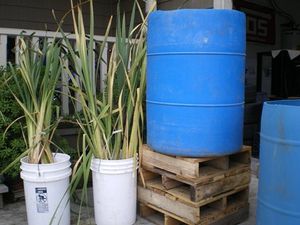
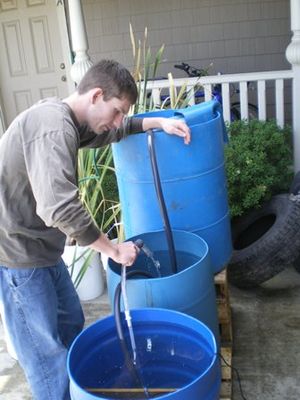
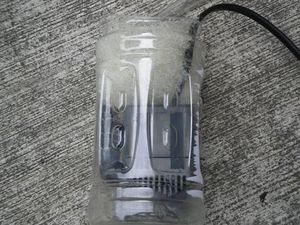
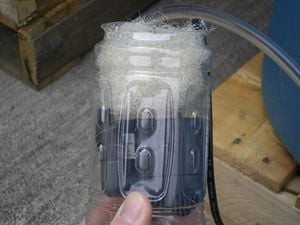
| Quantity | Material | Source | Cost | Total |
| 5gal Buckets | assorted | |||
| 1 | bathtub | used, private | ||
| 3 | Caulk | ace | $7 | $21 |
| 3 lb | Reeds | collected | ||
| 2 lb | moss | collected | ||
| 1 lb | duckweed | collected | ||
| 1 lb | water hyacinth | nursery | $3.50 | $3.50 |
| 3 lb | aquatic plants | nursery | $10 | $10 |
| 10 ft | pvc piping and fittings | hardware store | $20 | $20 |
| 10 ft | tubing | hardware store/private | ||
| 1 | pvc cutters/saw | ace | $10 | $10 |
| 3 ft^3 | gravel | quarry | $10 | $10 |
| 2 ft^3 | sand | beach | ||
| tbd | hardware | ace | $12 | $12 |
| 6 | plant trays | nursery | ||
| 1ft ^3 | soil | shovel | ||
| 2 yr^2 | fiberglass covers | reclaimed | ||
| The final design cost less than $100. This was accomplished by incorporating reclaimed materials and using gravity to help power the system. | ||||
Weekly Outlook[edit | edit source]
- Collect containers, begin specimen growth (3/13/10)
- Design research, further enclosure material sourcing (3/20/10)
- Monitor growth, data collection, and experimentation (3/28/10)
- Finalize enclosure structure and begin filtration simulations (4/3/10)
- Continue filtration simulations and data collection (4/3/10 - 4/10/10)
- Optimize system vegetation based on testing (4/17/10)
- Faunal introduction, water quality testing (4/25/10)
- Continued water quality testing and adjustments (5/1/10)
- Final system assessment and fortification; recommendations for improvements and maintenance (5/3/10)
Sizing the System[edit | edit source]
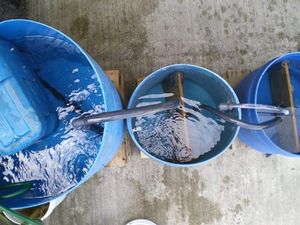
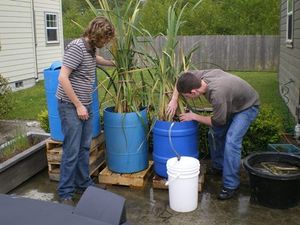
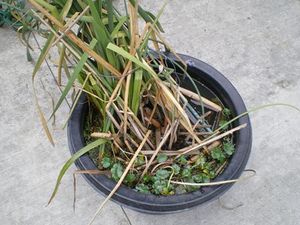
| INSIDE ACTIVITY | GALLONS USED (Conventional) | GALLONS USED (Conservative)1 |
|---|---|---|
| Toilet Flush | 5-7 | 1.5-3.5 |
| Shower | 7-10 (per minute)2 | 2-4 (per minute)2 |
| Bath (Full Tub) | 36-50 | 30-40 |
| Laundry Machine | 60 (top loader) | 42 (top loader) |
| Dishwasher | 15 (normal load) | 7.5-10 (normal load) |
| Dishwashing by Hand | 30 (tap running) | 10-20 (tap running) |
| Shaving | 20 (tap running) | 2-5 (tap running) |
| Brushing Teeth | 10 (tap running) | 2-3 (tap running) |
| Washing Hands | 2 (tap running) | 1-2 (tap running) |
|
1Individuals inhabiting the Air Ship will strive to be as conservative as possible. 2Average shower = 12-15 minutes (30-150 gallons depending on conservation)
| ||
The Design Process[edit | edit source]
Initial Design Sketches[edit | edit source]
A Changing Project[edit | edit source]
Initially, the scope of our project consisted of a rooftop aquaculture enclosure. As our research began to unfold, the sheer complexity of rearing fish on a rooftop in Brooklyn, NY became quite apparent. We would have to grapple with fluctuations in temperature from season to season, find ways to treat or filter the water in order to keep it from becoming toxic to the fish and then there was the issue of what species of fish could survive highly variable seasonal conditions. The entire process quickly became daunting and highly intricate. However, after speaking with our project contact we found that our clients had more of a need for a grey water filtration system that could be used to irrigate plants and vegetables on the rooftop space where the project was proposed. Many of the materials that we would use to construct such a system were already present on the rooftop in Brooklyn.
Through our research we identified several large scale treatment marshes, similar to the one presently functioning in Arcata, CA, which were quite effective but our difficulty was identifying a process to simplify these larger systems into something we could fit into a series of barrels on top of a roof. We first considered using long troughs filled with wetland species known to remediate contaminated water but this design idea would take up a large area and it would also violate the most important constituent of our criteria: weight. Our group couldn't identify any way that we could incorporate water, a growing medium, a lightweight enclosure trough and wetland plants in a manner that would avoid contributing significant weight to the system. Once again we were struggling to assess the viability of any existing design that we could incorporate in our project area. Luckily, the building in Brooklyn was constructed in a manner that would support several additional floors so it was robust enough to handle at least a few hundred pounds spread over a small amount of square footage. The WaterPod project gave us the inspiration to incorporate a barrel-based system in our own project. After reviewing several designs of water treatment systems in our research we identified this type of infrastructure as being our preferred alternative to mimicking the large pond-like system that exist in wastewater treatment.
-
Fig 1: Baffles prevent the formation of anaerobic conditions.
-
Fig 2: 3 Barrel System: Settling Tank & 2 Treatment Cells.
-
Fig 3: Treatment cell that will be filled with Bull Rush & Cattail.
-
Fig 4: Grease trap made from a reclaimed water jug.
Collect, Build and Test…Well Not So Fast[edit | edit source]
Once we let our imaginations go to work on the design of our grey water treatment system we were quickly overwhelmed by a vast array of questions. How many barrels do we really need? How big should the system be to support the water usage of 1-2 individuals? How would it all fit together? How much water do people really use in an average day? Questions like these and a whole lot more quickly complicated our design process. On top of that, local scrap yards and nurseries were not interested in donating barrels but instead they wanted $80-$250 for each one. Our goal was to stay well under $200 and hopefully not even get close to that figure by incorporating as much reclaimed and recycled materials as possible. We began checking out used barrels that were at the Arcata Recycling Center and other local sources. Who would've thought that the hardest question to answer would be; do you know what used to be in this barrel? Most heavy duty barrels are used for the storage of chemicals and industrial waste. Others are used to ship food grade oils and glycerin. These were the ones we wanted. Luckily we had a contact on campus and were able to acquire three barrels that had been empty for years and were sitting around collecting rainwater. As simple as it may seem, it was still a relief to have enclosures for our system and the basis for the infrastructure needed to build the treatment system.
Our research was also heavily focused on wetland plant species that would perform bioremediation of the grey water to provide us with a safe end product. A visit to the Arcata's local wastewater treatment plant shed some light on what species we would be using in our system. One of the recommendations that Andrew made was to be sure and mimic natural systems. Looking at the oxidation and settling ponds at the treatment facility two particular species were widespread and notably involved in remediating the wastewater. These included the common cattail and bulrush. The two species grow together as well and since the cattail has shallower roots versus the bulrush's deeper roots, more of the water column could be efficiently filtered. Both species were readily available in local water bodies and luckily we were able to obtain both species at no cost besides going elbow deep into the mud to ensure a viable root system was extracted. It was spring at the time this project was being constructed and many of the species were coming out of dormancy for the summer growing season. However, cattail extracted in early March were absent of significant new root growth. For this reason most of the viable plant life harvested for use in our system was extracted in April when noticeably larger roots were emerging from the base of the cattail and bulrush. We took the species and introduced them into 5 gallon buckets of water to allow continued growth and a viable root system that would adequately filter the grey water entering our system. The next step in our design process involved addressing an important issue that was continually apparent in our research materials; how to prevent anaerobic conditions from developing.
-
Fig 5: Water exchange hoses attached to the baffle.
-
Fig 6: A reclaimed oven shelf keeps the plant roots suspended.
-
Fig 7: A 15W aquarium pump re-circulates water for more extensive treatment.
-
Fig 8: The system flowing with the help of gravity.
Water Circulation, Baffles and Avoiding Anaerobic Conditions[edit | edit source]
Bacteria that colonize around the roots of wetland species create symbiotic relationships with the plants that provide them with a sanctuary to proliferate. Both the bacteria and microorganisms that colonize in a microbial slime amongst the cattail and bulrush roots work to remediate the water along with the plants. Having healthy colonies of these organisms greatly increases the filtration capacity which will be of great importance in our own system. These organisms require oxygen to metabolize toxic matter in the water and when they don't have this oxygen they die and anaerobic conditions are created which produce strong odors that wouldn't be desirable in a residential greywater treatment system. Since our system incorporates three barrels totaling approximately 120 gallons, it was paramount that we prevent stratification of the water column and do whatever is necessary to encourage mixing within the water column.
To discourage the formation of anaerobic conditions in our system we incorporated baffles into the barrels that would force the water column to mix. We got this idea from our research where we observed numerous systems incorporating just this idea. Although none of the systems we looked at for inspiration used barrels and baffles together, we were confident we could get it to work. Furthermore, our goal was to be as low impact as possible with our design and instituting a large number of electric pumps to mix and aerate the water column wasn't a preferred option. While trying to battle anaerobic conditions it was becoming increasingly important that we also give the system adequate retention time that would allow proper remediation of the greywater. It was a difficult series of requirements to balance. We utilized gravity feeds from the settling tank to each successive tank in order to reduce the need for electric pumps and make the project as low impact as possible. However, we did use one small aquarium pump (~15W) in the last barrel to re-circulated water back into the first treatment barrel to ensure the grey water would be adequately treated. The pump basically re-circulates a trickle of water from the second treatment barrel back into the first in order to maintain a long retention time while avoiding the formation of anaerobic conditions. We also have recommendations to experiment with using bicycle pumps or other forms of manual circulation to address both of these issues as well. Unfortunately, one our midlevel criteria involved minimizing maintenance time to less than 3 hours per week so our initial design will attempt to address this criterion through the use of the small aquarium pump.
-
Fig 9: Top view of the system in action.
-
Fig 10: Microbial slime forms around the roots where bacteria colonize and remediate the grey water.
-
Fig 11: Healthy growth at the base of the Bull Rush.
-
Fig 12: The completed system with more testing and monitoring taking place in the future.
Results[edit | edit source]
The final design of our project reflects the criteria we set out to meet. The weight of the system has been kept at a minimum by incorporating plastic barrels but the system still exudes a lot of weight due to water. The cost of our system was also kept low by incorporating as many reclaimed infrastructure components as possible. The system is easily disassembled for maintenance, repositioning and for future improvements. Testing of the water filtration capacity of the system must be conducted in the future before any legitimate claims can be made on its safety for use on plants destined for human consumption.
It's our recommendation that the system be tested in the future for BOD, nutrient levels and overall water remediation. For this to take place the wetland species we have introduced in the system need a full growing season to establish an adequate root system that provides the appropriate level of biological filtration. We encourage further experimentation of alternative aeration methods, recirculation techniques, species compositions and greywater concentrations. We also recommend the following actions as ways to improve and extend the performance of the system:
- Manual aeration techniques. (Bicycle pumps, foot pump etc.)
• Use of renewable energy sources to power recirculation. (Solar, wind and waste heat)
• Use of remediated water to grow tree saplings for use in restoration projects.
• Experimentation with additional treatment cells to increase the capacity of the system.
• Implement alternative baffle designs and arrangements.
• Find a way to enclose the settling tank and treatment cells while still maintaining plant life.
• Experiment with alternative grease trap designs i.e. Floating grease trap that fluctuates with water levels.
• Develop an alternative method to manual siphoning after maintenance.
• Further/more extensive protection of the recirculation pump to lower maintenance requirements and to extend the life of the pump.
• Use sand and gravel to aid filtration and recirculation near inlets and outlets.
Literature Review[edit | edit source]
Aquaculture Filtration & Chemistry[edit | edit source]
Numerous concerns exist in aquaculture with regard to water quality and the toxicity of the environment. This resource outlines filtration methods, control methods for water quality, and various suggestions for marine and freshwater filtration systems.[1]
Types of Species Used In Aquaculture[edit | edit source]
This book provides a wide array of useful material including descriptions of different species of fish and grayfish that can be utilized in aquaculture. Furthermore, this reference provided me with information on small scale aquaculture systems that will be comparable to the one me teammate and I are designing. It also makes recommendations for cold systems which we will be applying for the climate present one the east coast during the winter.[2]
General Aquaculture Info. (Diseases)[edit | edit source]
This resource provides a wide array of information on general aquaculture procedures. However, the most valuable section covers different types of diseases that affect aquaculture systems, especially those on a smaller scale. This book does a great job of covering a large amount of information involving harvesting, nutrition, and feed types. Furthermore, several potential species that can be used in our small scale system are listed and described in this text.[3]
Integrated Systems: Seaweed and Vegetables with Aquaculture[edit | edit source]
This peer reviewed article discusses various facets of the global economics behind aquaculture. It states useful facts regarding global aquaculture production and future needs projections. This article also discusses integrated systems that use vegetables as well as fish. Seaweed production is also considered a viable aquaculture product. Various topics are discussed but the majority of the article revolves around integrated systems with seaweed and the economic impacts of aquaculture.[4]
The potential for constructed wetlands for wastewater treatment and reuse in developing countries: a review[5][edit | edit source]
Information about the usefulness of different plants and physical features of greywater systems, especially uptake values for different aquatic plants highlighting water hyacinth
Recycled vertical flow constructed wetland (RVFCW)—a novel method of recycling greywater for irrigation in small communities and households[6][edit | edit source]
Article reviewing sizing a greywater treatment system and their capacity to filter water
The use of vertical flow constructed wetlands for on-site treatment of domestic wastewater: New Danish guidelines[7][edit | edit source]
Review of in-ground greywater treatment systems, and the Danish guidelines regulating their implementation
General Wetland Info w/ Arcata as Example[edit | edit source]
A great website with species specific information about wetland species that are local to Arcata and Humboldt County. Nice details on the species we are trying to incorporate into our own system: Cattail Family (Typha Latifolia) and the Common Rush (Juncus Effusus), particularly Bull Rush.[8]
Guide to all plants with fact sheet attachments:
[edit | edit source]
Detailed fact sheets are provided for Bull Rush and Cattail by the Natural Resources Conservation Service. This is a vast plant resource with very valuable information on all classifications of plants.[9]
Great resource for wetland plant species (mail-order available):
[edit | edit source]
An interesting resource with the option of mail-ordering some of the plants, trees and shrubs. This will be a last resort if we cannot collect our own plants. This nursery is run out of Salem, Oregon which will prevent species from being introduced into a completely different habitat that would adversely affect their acclimation and growth.[10]
Examples of common and cheap wetland plants can be found here along with a general overview for grey water filtration.[edit | edit source]
This webpage provides a nice amount of introductory information that can get people thinking about grey water systems and the plant species that will be beneficial to incorporate into them. I recommend this page as a way to introduce people to the concept of filtering wastewater.[11]
Wetland Diagram[edit | edit source]
This page contains a diagram of water depths and correlating species found in various types of wetlands. It does a great job of conveying the natural transitions that take place between hydric soils and non-hydric soils. This would be a great graphic for educating people on the various types of sub-habitats that exist and ultimately makeup an entire ecosystem. Several types of species are outlined in each hydric soil category and it really speaks to the variety and uniqueness of wetland systems.[12]
References[edit | edit source]
- ↑ Spotte, Stephen. Fish and Invertebrate Culture. New York: John Wiley & Sons, 1970. Print.
- ↑ Romanowski, Nick. Sustainable Freshwater Aquaculture: The Complete Guide from Backyard to Investor. Sydney: Unsw Press, 2007. Print.
- ↑ Stickney, Robert. Aquaculture: An Introductory Text. 2 ed. New York: Cabi, 2009. Print.
- ↑ Neori, Amir , Thierry Chopin, and Max Troell. "Integrated aquaculture: rationale, evolution and state of the art emphasizing seaweed biofiltration in modern mariculture." Aquaculture 231.1-4 (2004): 361-391. Print.
- ↑ http://dx.doi.org/10.1016/S0925-8574(00)00113-0
- ↑ http://dx.doi.org/10.1016/j.chemosphere.2006.06.006
- ↑ http://dx.doi.org/10.1016/j.ecoleng.2005.07.009
- ↑ http://web.archive.org/web/20100530235553/http://www.nwplants.com:80/plants/wetlands/wet_index.html
- ↑ http://plants.usda.gov/java/factSheet?sort=comname
- ↑ http://www.nwplants.com/business/catalog/index.html
- ↑ http://bogs-marshes.suite101.com/article.cfm/marsh_plants_that_clean_grey_water
- ↑ http://www.newp.com/wetland.jpg
Online References[edit | edit source]
http://web.archive.org/web/20111028140237/http://americancity.org/magazine/article/martin-schreibman/: Aquaculture Scientist Interview
http://www.newburyportnews.com/permalink/local_story_228144543:College professor promotes urban aquaculture
http://web.archive.org/web/20150221214321/http://aquaculturetanks.net:80/hybrid-striped-bass/: Hybrid Striped Bass & youtube videos of aquaculture
http://web.archive.org/web/20130121213752/http://www.pondsolutions.com:80/holding-tanks.htm: Holding tanks with prices
http://www.buildinggreen.com/auth/article.cfm/2009/1/29/Growing-Food-Locally-Integrating-Agriculture-Into-the-Built-Environment/Aquaponics: Aquaponics information







